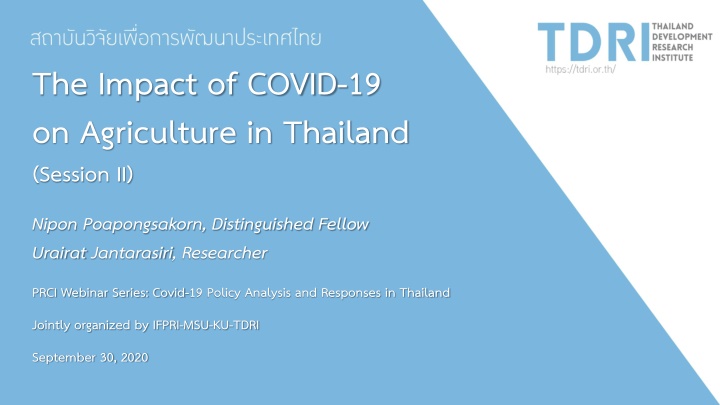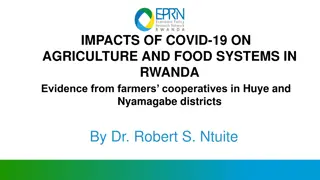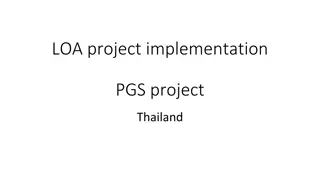Impact of COVID-19 on Agriculture in Thailand: Insights and Responses
The webinar highlighted the economic impact of COVID-19 on Thailand's agriculture sector, with a focus on supply chain disruptions, reduced demand, and reverse migration affecting farm households. Government responses such as cash handouts and loan measures were discussed, along with concerns about the effectiveness of medium-term economic restructuring policies.
Download Presentation

Please find below an Image/Link to download the presentation.
The content on the website is provided AS IS for your information and personal use only. It may not be sold, licensed, or shared on other websites without obtaining consent from the author.If you encounter any issues during the download, it is possible that the publisher has removed the file from their server.
You are allowed to download the files provided on this website for personal or commercial use, subject to the condition that they are used lawfully. All files are the property of their respective owners.
The content on the website is provided AS IS for your information and personal use only. It may not be sold, licensed, or shared on other websites without obtaining consent from the author.
E N D
Presentation Transcript
The Impact of COVID-19 on Agriculture in Thailand (Session II) Nipon Poapongsakorn, Distinguished Fellow Urairat Jantarasiri, Researcher PRCI Webinar Series: Covid-19 Policy Analysis and Responses in Thailand Jointly organized by IFPRI-MSU-KU-TDRI September 30, 2020
Key messages Macro impact of Covid-19 Thailand has been praised as one of the top countries that successfully contained the Covid-19 pandemic, yet the successful health policy has come with a high economic cost. Impact on agriculture The direct impact on agriculture GDP was relatively mild, comparing to that of the top three most affected sectors, which have high linkage with the tourist industry, i.e. (1) accommodation & food service, (2) art entertainment & recreation, and (3) transport & storage, Two main channels of direct impacts are: Supply chain and logistics disruption both in international trade and domestic trade during the period of lockdown & curfews Reduction in demand by both foreign tourists and Thais, caused by a ban on international travel, business lockdown, and WFH measures Yet indirect impact on agricultural households is more serious than direct impact, caused by reverse migration Farm households lost large sum of income from non-agricultural sector, which accounted for 65%-74% of their household income. Laid-off workers in the non-agri sector, who came back to their farm families, must survive on agricultural income of 26%-35% Many farm households, particularly the poor, have become highly vulnerable
Key messages (cont.) Government responses The cash handout is the major single policy to mitigate the Covid-19 impact on household income, while the softy loan measures are quickly implemented to resolve the looming debt problems of business and small borrowers Although the cash handout is a semi-universal program, it has two serious errors (a) inclusion errors, (b) exclusion errors, particularly the poor who do not have access to smart phone or do not know how to register online Most family members of agricultural households are entitled to receive the cash handout from one of four policy channels Yet some of 4.5 family members who work in the non-agricultural sector do not receive any subsidy because their names are in the farmer registration system
Key messages (cont.) Government responses (cont.) The medium-term policies of economic restructuring and employment creation have slow progress and the existing 46,111 project proposals may not achieve the objectives of employment creation and economic restructuring due to the inherent weakness of project formulation by the bureaucrats Implications for the economic restructuring policy Three major concerns about the current restructuring programs (using 400 billion baht of loan) are raised The speakers also identify three policy challenges
Outline Objectives and Methodology Policy response timeline Macroeconomic impact Impact on Thai agriculture Government responses: Does the cash handout help mitigate the shocks? Implication for the restructuring programs
Objectives and Methodology Objectives To describe the timeline of economic policy to mitigate impact of Covid-19 To briefly present the macroeconomic impact of Covid-19 To analyze the direct and indirect impact of Covid-19 on Thai agriculture To explain the policy response, emphasizing policies that affect agricultural households To draw some policy implications Methodology Using a qualitative method to assess the economic policies Using secondary data and drawing from some findings of previous studies Hypothesis: direct impact on agriculture production is not so serious as the indirect impacts on agricultural household income
Thailand has been praised as one of the world most successful countries in containing Covid-19 Thailand was able to identify the world first Covid- 19 infected case outside China due to prompt and effective surveillance system It has managed to flatten the new infection curve and prevent new infection in a short time period, thanks to the professional disease control management, effective and credible public communication as well as public cooperation in adopting essential preventive measures, especially mask wearing, social distancing, and efficient tracing by the network of village health volunteers This second webinar wants to describe the economic policy response and qualitatively assess its impact in the short-term 14 Jul: Egyptian soldier & Sudanese Diplomat s daughter incidents 4 May: 1st day of no domestic infection There was only one local infection In the last 127 days, (as of 30 September) 9 Mar: Thonglor ent. venue incident 6 Mar: Boxing Stadium incident 4 Feb: Thai citizens returned from Wuhan 3 Mar: Thai workers returned from Rep. Korea 31 Jan: 1st local transmission 1 Mar: 1st death 13 Jan: 1st case in Thailand
Policy responses timeline 17 May: Easing II Curfew: 11 PM 4 AM 15 Jun: Easing IV Curfew revocation 1 Jul: Easing V 1 Jun: Easing III Curfew: 11 PM 3 AM Government spending has helped to mitigate the impacts of COVID-19 on individuals, but the amount is limited and speed is slow. There were three phase of government response started at 10th March until now, the total budget line of government response is 2 trillion baht (14% of GDP). 19 Apr: Gov t approved 3 Royal Decrees to borrow money 1.9 trillion baht 18 Apr: Active cases Finding in risk-prone areas 8 Apr: financial aid 15,000 baht/person Nobody will be left behind 3 May: Easing I 9 Jul: Economic & Social rehabilitation projects were approved 92 billion baht from 400 billion baht 7 Apr: Active cases Finding in risk-prone groups 6 Apr: Int. Flights ban 3 Apr: Imposing Curfew:10 PM 4 AM 2 Apr: Imposing State Quarantine 26 Mar: Emergency Decree 22 Mar: BKK Lockdown Economic policies Health policies 20 Mar: Monetary policy BOT buy Gov t bond 100 billion baht 17 Mar: Free test for Patient Under Investigation 3 Jan: Health checks at int. airports
Policy responses Policy response to help, rehabilitate, and mitigate COVID-19 impact Policy Response Phase I 10 Mar 2020 Phase II 24 Mar 2020 Phase III 7 Apr 2020 Total Budget line (Million Baht) 396,024 Disbursement (Million Baht) 201,474 Thais/ Business Target group Budget of state enterprises and specialized financial institution Budget of state enterprises and specialized financial institution SSI fund SSI fund 142,000 89,562 Labor (social security insurance) 503,903 Royal Decree:financial stability (BoT) budget line: 400,000 million baht Royal decree: Soft loan (BoT) budget line: 500,000 million baht Royal decree: borrowing 1 trillion baht budget line: 1 trillion baht 1,900,000 2,438,204 780,366 Source: NESDC, Sep 21, 2020 14.2% of GDP in 2019
Nine soft loan measures to assist households affected by COVID-19 Phase I State 2 : July 2020 For Non-NPL credit card: reducing interest rate 12% for credit card 22% for performing loan Reducing minimum payment due to 30% Expanding term loans to 48 months For hire purchase or leasing: A loan payment holiday of 3 months or Expand term loans Unlocking limit For housing loans A loan payment holiday of 3 months or 3 months for principleonlywith reduced interest rate or expand term loans Unlocking limit For NPL credit card and Personal loans If remaining debt <50%, can borrow more money State 1 : April 2020 For credit card: Reducing minimum payment due From 10% to 5% (end 2021) 8% (2022) 10% (2023) [4.7 M.Acc. 0.2 T. ] For Personal loans or Auto title loans: A loan payment holiday of 3 months or reduce 30% of interest rate [3.6 M.Acc. 1.4 T. ] For hire purchase or leasing: A loan payment holiday of 3 months or 6 months for principleonly(limit 35k - 3 mil. by type of product) [2 M.Acc. 0.7 T. ] For housing loans: A loan payment holiday of 3 months and reduce interest rate[limit 3 mil. ] [1.2 M.Acc. 1.5 T. ] For NPL credit card and Personal loans: A loan payment holiday of 6 months or reduce interest rate -2%
Government Cash Hand-out Government Cash Transfers Phase II Welfare card Bt3.6bn Vulnerable groups Bt20.3bn Government Cash Hand-out Government has transferred 612 billion baht (4% of GDP) to almost 30 million Thais from May to July. The largest number of transfers is for the Nobody will be left behind program in which 15,000 baht were transferred to 14.2 million informal sector workers, followed by transfers of Bt15,000 to 7.4 million agriculturists. Water Bt2.8bn Electricity Bt32.7bn Agriculture Bt111.0bn Social Security Bt229.0bn 612.5 Billion baht Informal sector workers/ Nobody will be left behind Program Bt213.0bn Source: Related ministries and government agencies
Soft loan measures to assist SMEs affected by COVID-19 and to stabilize corporate bond market: 4 measures Phase III Measure 1 : A loan payment holiday of 6 months for all SMEs with a credit line not exceeding 100 million baht Measure 2 : Soft loans to support liquidity for SMEs with a credit line not exceeding 500 million baht Royal decree: Soft loan (BoT) budget line: 500,000 million baht Measure 3 : Market liquidity enhancement to stabilize the corporate bond market Measure 4 : Reducing the FIDF fee to ease the loan interest burden of businesses and households. Royal Decree: financial stability (BoT) budget line: 400,000 million baht
Economic restructuring projects These projects was funded within the budget (the 400 billion baht) from Royal Decree to borrowing 1 trillion baht. Phase III List of approved projects (as of 30 Sep 2020) Strengthening grass-root economy (2 projects) 14.59 Billion baht Cluster farms & market linkage 13.91 Billion baht Tourism promotion (3 projects) 22.40 Billion baht Employment Measures Co-payment: new employment for 260,000 new graduates government support 50% of wages for 12 months Maximum 7,500 baht/month Total budget is 23.45 Billion baht
Macroeconomic impact GDP Growth of Thai export value by Major Products Q2/2020 GDP declined by 12.2%yoy basis In 2020, Thai economy is expected to contract around 10% this year with impacts from the global economic slowdown and travel restrictions due to COVID-19 pandemic. The Inflation rate was -1.7% in Jun 2020. Export total export growth Q2/2020 shrank at -15.2%yoy Agricultural export had declined in the first quarter, but increased by 0.3% and 1.7% between April and May 2020, respectively. Agriculture Manufacturing Arms & ammunition Gold Total exports Other exports Total exports (excl. gold, Arms & ammunition) 15 10 5 0 Percent -5 -10 -15 -20 -25 -30 Q1 Q2 Q3 Q4 Q1 Jan Feb Mar Apr May 2020 2019
Macroeconomic impact (cont.) Employment & Unemployment rate Employment has dropped by over 1 million in April. Unemployment rate increased from an average of 0.8% during 2014-18 to 1.7% in April 2020 in all sectors, especially in construction. Unemployment may be 3-5 million in September. (KKP research) Number of unemployment benefit claims from the social security schemes rose rapidly since April, reaching over 1.37 million under Article 33 and 0.9 million under Article 75 in the first half of the year. Unemployment rate (%) Average 2014-18 April 2019 April 2020 Unemployment benefit claims under social security scheme Article 33 2.8 332.1 3 350 2.2 2.5 300 1.7 Thousand persons 2 215.7 250 1.3 1.2 176.9 173.8 1.5 0.81.0 0.9 200 Percent 0.7 134.7 0.6 1 150 0.3 0.3 0.1 0.5 100 0 50 0 Average 2014-18 April May April May 2019 2020 Source: Labor Force Survey and Social Security Office with TDRI calculation
Impact on Thai Agriculture Direct impact The direct impact on agriculture GDP was relatively mild, comparing to that on the top three most affected sectors, which are related to the tourist industry Incomes of agriculture households have also declined with the fall in production from drought, while incomes from non-farm activities (60% of their total incomes) & remittances have also declined due to COVID-19. 20.0% 7.4% 10.0% 2.1%0.2% 1.7% 1.7%0.4% 0.0% -1.4% -10.0% -6.0% -8.6% -11.5% -13.3% -9.8% -3.2% -14.0%-14.0%-14.4% -12.3% -20.0% -14.7% -12.2% -30.0% -25.0% -40.0% -38.9% -50.0% -46.0% -50.2% -60.0% 15 Q1/202 0 Q2/202 0
Impact on Thai agriculture (cont.) Export growth of agricultural product Jan Apr 2020 (Positive) Direct impact (cont.) 25% 20% The COVID impact on export have both positive & negative effects: Positive impacts on instant food and dried food e.g. molasses, cocoa Export of fresh products declined because of interrupted logistics, declining in demand, and export ban on eggs 15% 10% 5% 0% Molasses Soups and broths and preparations Average growth for 6 years (2015-2020) compared to 2019 Export growth of agricultural product Jan Apr 2020 (Negative) Ice cream Cocoa and cocoa preparations chewing gum 200% 150% 100% 50% 0% -50% -100% -150% Chilled boiled shrimp Average growth for 6 years (2015-2020) Tobacco leave Nuts Egg jellyfish compared to 2019 21 Source: MOC, June 2020.
Major sources of direct impact on agriculture Direct impact (cont.) Thai economy depends heavily on the external sector, especially export and tourism. Disruption in international supply chain resulted in temporary declining in export Domestic supply chain disruption from lockdown & curfew measures seriously affected fresh produces Declining food demand due to declining number of tourists after a ban on international flights (- 66.2%yoy from 40 million foreign tourists) Declining in domestic demand because of closing business activities, i.e., customers were not allowed to eat in the restaurants & food shops, except take away food service - Thus Online sale have been booming e.g. Grab food, Food Panda - Curfews also reduced the sale of convenient stores and eating places in the morning and evening 22
But agricultural households are more seriously affected by the indirect impact of Covid-19 Indirect impact Employment / income Employment / income structure of farm households structure of farm households 65-74% of farm household income are from non-agric activities because farm households have 9.58 million workers in non-agricultural sector. -6.94 mil from the Northeast and the North Highly vulnerable because -80% are casual workers -45% aged 46-60 years old (Source: SES, taken from PIER 2020) Source: PIER 2020
But agricultural households are more seriously affected by the indirect impact of migration Indirect impact (cont.) The disappearance of foreign tourists led to a reverse urban-rural migration, because millions of workers in the tourist-related sectors (accommodation & food service, art entertainment & recreation, & transport) become unemployed and had to return to their farm families. The number of unemployed workers who returned home may be 3-5 million (guestimated) PIER Survey finds that 75% of farm households have unemployed persons or members with reduced working hours, most of whom from the service sector - The North and the South have largest share of such cases (90%), followed by the Northeast (75%) and the Central (70%) - The average number of unemployed is 1.5 per household 24
Why is the indirect impact very large? Sources of impact Indirect impact (cont.) Very large income shock: farm households lost the major source of their income from the non-agricultural sector (65%) and remittance (12% of households) Farm income is only 26-35% of agricultural household income (SES and PIER Survey) The poorer households depend more heavily on non agri income Moreover, unemployed family members came home and must live on the 26-35% income from agriculture, which is also affected by Covid-19 Thus agriculture is no longer the sufficient safety net, and poverty will increase sharply. In 1997, when urban workers were laid off and returned home, farm income was more than 50% of agricultural household income 25
Sources of indirect impact on agriculture (cont.) The dependence on non agri income of agri households by income status Indirect impact (cont.) Farm income is only 26-35% of agricultural household income (SES and PIER Survey) The poorer households depend more heavily on non agri income. average high lowest highest low middle Non agri income (remittance) Agri income The survey about proportionof agri household income 2020 Agri income as percentage for farm household income between 2002 & 2019 2019 2002 26 Source: Chantarat et al. (2020)
Vulnerability in low-income farm household Indirect impact (cont.) Consequently, the farm households, particularly the poor, are highly vulnerable. Cash flow Cash flow Source: BOT. Source: Chantarat et al. (2020) 27
Farm incomes may recover in 2020H2 but remains less than last year s YoY Growth of Farm income by Crops (5M2020) Farm incomes in the 5M2020 declined by 1.2% yoy from down in paddy and sugarcane production. In 2020H1, Production of rice fell by 35.7% and sugarcane by 14% from severe drought Rubber and sugar prices have declined with oil prices. This is despite the Bt56 billion transfers under Price Insurance schemes for rice, rubber, cassava , oil palm, maize from Oct 2020 to July 2021. Farm incomes should recover in 2020H2 but remain lower than last year s as Production and prices recover, but will remain lower than last year s Overall incomes of agriculture households will fall this year as 65% of their incomes are from remittances & non-farm work which have collapsed after the COVID-19 outbreak. 30 Price Production Farm income 20 10 0 Percent -10 -20 -30 -40 Agricultural Production -0.7% 100 2019 74.9 74.4 80 -6.6% Million tons 60 +3.0% +8.4% +1.4% 31.3 29.3 40 17.3 16.8 20 4.9 4.8 4.7 4.3 0 Sugarcane Source: Office of Agricultural Economics with TDRI calculation Rice Oil Palm Rubber Maize
Government response Almost universal cash hand-out of 414 billion baht for 30.5 million individuals from 10 target groups Financial policy, particularly the soft loan assistance for business and individual borrowers, using 900 billion baht (not discuss here) Economic stimulus/restructuring policies 400 billion baht 30
Cash hand-out policy Summary of cash hand-out expenditure & sources of fund Bill 414.735 Bill 297.286 n.a. Sources Use Planned Borrowing Fiscal budget Balance (mid Sept. 2020) 344.735 70.00 210.265 31
Government response : cash hand-out by target groups (cont.) Reimbursed (No.) Mil 7.526 Eligible No. (mil) Targeted groups Bill baht 114.352 Farmers (5,000 x 3 m) NOLB: Employers/self- employed (5,000 top up x 3m) 10 16 15.302 159.584 Vulnerable persons (1,000 top up x 3 m) Wage compensation for employees 6.87 6.65 20.154 0.06 0.007 109 mil Social security insured employees (not eligible under SSI law) 59,776 persons 59,776 persons 896.64 mil Social welfare recipient (1,000 top up x 3 m) Total (1) 1.16 1.025 3.087 30.51 297.286 45.0 32
Government response : cash hand-out by target groups (cont.) Reimbursed No. Eligible No. Bill Additional policies (NOLB budget) - Shopping subsidy for social welfare recipients (500 x 3m) - Shopping subsidy for registered population (100 /day x 15 days) Social security insurers Unemployed force majeure Unemployment benefit Labor protection law (clause 75) Total (2) Note : Note : 1 1) The monthly bills for household electricity and water are also reduced ) The monthly bills for household electricity and water are also reduced * September * September 2020 2020 14 14* 21 30 30* 45 0.92 0.42 0.79 2.1898 0.92 0.42 0.75 2.1898 n.a. n.a. n.a. 33
Question: how many workers are affected by Covid-19 ? To assess the effectiveness of cash handout policy, it is necessary to identify the number of workers affected by Covid-19, using the Labor Force Survey Method : differences of labor force between Q2/2020 and Q2/2019 Changes in labor force (million persons) 1) Unemployed (increase) +0.368 2) Employed (increase) > 20 hours (-) 1-20 hours (+) 0 hours (+) + 2.081 3) Not in labor force (+) 4) Total labor force - 0.701 - 3.635 + 0.843 +0.413 -0.333 No. of labor force affected by Covid-19 (1+2.1+2.2+3) is 3.714 million 34
Some observations The figure of 3.174 million workers affected by Covid-19 is seriously underestimated, comparing to unemployed persons under the social insurance system No. of affected workers under social insurance system is 0.9 million out of 11 million people (Sept. 2020) Temporary work stoppage 1.7 million workers (June 2020) Analysts estimate that the number of unemployed and workers with lower working hours may be as high as 11.8 million persons (Bank of Ayuddhaya 2020) Informal workers are 18-20 million (50%) Most affected workers in the tourist industry are in the informal sector Why is the number of affected labor under-estimated ? Sampling frame is fixed for 10 years Survey method : 60% of respondents Definition problems People do not cooperate in answering the questionnaire 35
Research questions Why are there so many people (30.5 million) receiving cash handout ? Are there any serious errors in the cash transfer administration? Do agricultural family members working in non- agricultural sector receive the cash transfer ? Does the cash hand-out sufficiently mitigate the short-term liquidity problems of the agricultural households which used to depend heavily on non-agricultural income and remittance from their family members? 36
Research question1 Why are there 30.5 million people receiving the cash hand out? Populist policy !!! The government decided to launch cash handout to all affected workers under the No one left behind (NOLH) program and other schemes Affected workers were asked to register by answering a short questionnaire 28 million people registered, including large number of not-in-the labor force (NLF), and 15 mil received the subsidy Many people in NLF, indirectly affected as the family prime earners are laid off, also applied Government also decided to help 10 million farmers, those under the social welfare card scheme who did not received cash transfer under the NOLH, those under the social insurance scheme, etc. In summary there are 10 targeted groups that are eligible for cash handout. 37
Are there any serious errors in the cash transfer administration Two types of errors in targeted Two types of errors in targeted welfare program welfare program Inclusion error : Those who are not affected, directly or indirectly, but applied for cash Many of 15 million under the NOLB and 7 million registered farmers may be in this group Exclusion error : Poor people who failed to register Preliminary information's from SES show that 60-64% of poor did not register in the social Welfare Card system Population Non-target group Target group Exclusion Exclusion error error Right target Right target Inclusion error Inclusion error
Are there any serious errors in the cash transfer administration? Two types of error (cont.) Unfortunately, since the Ministry of Finance does not disclose the registration information, we can t tell how large is the error Further research is necessary so that the government subsidy scheme can be streamlined in the future. 39
How serious is the Covid-19 impact on the farm families whose members used to work in the non-agricultural sector? 60-65% of farm household income is from non-agricultural sector, according to SES A study of Covid-19 impact on farm households, using survey data from 720 households (PIER 2020) shows that 76% of farm households have income from non-agricultural sector, accounting for 80% of their household income 40% of farm households depend on remittance 75% have either laid-off workers or members with reduced working hours 50% of unemployed workers are in the service sector, 18.7% in construction, 6.3% in trade 90% of families in the North and South (tourist destinations) and 70% of those in the Northeast and the Central regions have such affected members, The average number of affected workers is 1.5 persons per household (out of 3) Families with smaller land are affected more than the large ones 40
A proxy of indirect Covid-19 impact on agri-household : Occupation composition of household members in the agri-household. Highlights are affected informal informal workers in tourist-and services industries Occupations Occupations Total Total Employment status (% of each occupation) Employment status (% of each occupation) Gov't , State Enterpris e Employe e 7.5% 60.9% 12.1% 4.9% 65.4% 29.2% 3.1% 51.6% 45.1% Own Account, Unpaid Family Workers Private Employe e Employe r Casual workers (in Agricultural Household) (Mil.) % Group Sub total 19.2% 0.4% 0.1% 0.0% 0.0% 0.1% 0.2% 100.0% 0.1% 100.0% 0.0% 100.0% Executive Professional Clerk Service staff, Cleaning worker and other Farmers and ag labor Technician and Machine operator Food processor, Restaurant worker and Hawker Construction and transport workers Non-Labor force Total Source: LFS, NSO. 0.27 0.66 0.33 0.9% 2.3% 1.1% 2.7% 2.7% 7.1% 7.1% 1.1% 59.4% 59.4% 9.3% 27.4% 0.0% 100.0% 2.10 3.0% 3.0% 3.0% 3.0% 1.4% 2.9% 27.1% 87.5% 27.1% 0.5% 2.7% 7.6% 63.2% 0.0% 100.0% 1.0% 100.0% 10.84 1.14 36.9% 3.9% 3.9% 0.9% 73.2% 73.2% 0.8% 24.6% 0.4% 0.1% 100.0% 0.42 1.4% 0.5% 16.0% 16.0% 5.8% 5.8% 2.7% 2.7% 43.6% 100% 5.4% 71.8% 0.5% 100.0% 0.80 12.80 29.37 0.27 11.53 1.10 3.18 0.46 0.02
Do most of the affected workers in the non-agricultural sector, who return to their farm family, receive the cash subsidy from any of the cash transfer schemes? Out of 30.5 million people who received cash subsidy, 7.526 are farmers PIER (2020) finds that 76% applied for the agricultural subsidy 20% of farm households have members under the SSI 65% applied for the no one left behind subsidy 20% applied for the debt restructuring program of Bank for Agriculture and Agricultural Cooperative (BAAC) 42
Do most of the affected workers in the non-agricultural sector receive the cash subsidy from any of the cash transfer schemes? (cont.) Yet 4.2 million unemployed workers, whose household heads registered as the farm households, are not entitled to the NOLH subsidy because their name is in the farm registration Despite the fact that they might use to work elsewhere and were not farmer With the last exception, cash subsidy has more or less mitigated the short-term liquidity problems of most farm families and their members, who are laid off from the non-agricultural sector 43
Economic restructuring projects The government has planned/ is planning the economic restructuring/stimulus program, using the borrowing money of 400 billion baht NESDC has already received more than 46,000 proposed projects from government agencies, totaling more than 800 billion baht Only 6 projects with 50.9 billion baht budget have been approved. The slow approval process may be due to the change in economic ministers and political bargaining List of approved projects (30 Sept 2020) Strengthening grass-root economy (2 projects) 14.594 Bil Cluster farms & market linkage Tourism promotion (3 projects) The first two agricultural related projects are not expected to generate high productivity improvement but will not be discussed here Most unemployed workers who return home do not have agricultural skills Production of commercial crops have low productivity, etc. 13.905 Bil 22.40 Bil 45
Only Bt38 billion has been approved from the bt400 billion loan Of the Bt1,448 billion (46,111 projects) proposed, Bt93 billion baht (195 projects) have passed NESDC s screening, of which 70% are job creation and agriculture-sector projects, 26% are tourism related projects and only 2% are construction projects. So far, only Bt38 billion or 0.25% of GDP (7 projects) have been approved for implementation by the Cabinet, of which Bt23 billion are tourism- related and the rest agriculture-related projects; most projects are nation-wide and can be disbursed within this September. For the rest of the year, out of the projects that have passed the NESDC s screening, those that can be quickly implemented will be prioritized such as in agriculture, job creation and SME business promotion (the latter is Bt2 billion). EXPECTED 2020 DISBURSEMENT (Billion Baht) 20 2.4 BUDGET (Billion Baht) PROJECT NAME ACTIVITY IMPLEMENTED AREAS We Travel Together Kumlungjai Increase consumption and boost tourism sector Increase consumption and boost tourism sector All provinces All provinces 157 wildlife refuges (57 provinces) Potential provinces All provinces 20 2.4 Developing Potential in Wildlife Tourism Develop quality tourism 7.4 0.4 Safe Tourism Zones One Tambon 1 New Agricuture Theory Developing model areas in promoting quality of life according to the new agriculture theory towards the Kok Nong Na Model Developing One Stop Service for Soil and Fertilizer for Communities Source: Compiled by TDRI; Disbursements calculated by TDRI Develop quality tourism Develop New Agriculture Theory: self-dependence 0.15 9.8 0.06 3.9 Develop New Agriculture Theory: self-dependence All provinces 4.9 3.1 Develop large and modern agriculture All provinces 0.2 0.06
Economic restructuring projects and major concerns Three major concerns 1) It is extremely difficult, if not impossible, to restructure the tourism-dependent economy in the short-term due to many rigidities and adjustment costs Thailand depended heavily on tourism, which is the second largest income-generating sector with 40 million tourists It will take at least 2-3 years for tourism to recover Yet it is unreasonable to expect a full recovery and back to a normal business As long as the international travel ban is not lifted (due to the public fear of second wave of Covid-19 infection), millions of workers will be unemployed, resulting in miserable lives of their families ten of thousands of SMEs will be bankrupted social unrest will be uncontrollable Economic crisis will be unavoidable 47
Three major policy concerns (cont.) 2) Except the recently approved employment projects for the newly college graduates and agricultural projects, the restructuring programs do not yet have any concrete employment creation projects that can create employment for more than 7-8 million workers in the tourist-related industry? Most workers have low skill and low education They do not have any agricultural skills because they left their farms when they were young 3) Another concern is that most of the 46,000 projects proposed by the government agencies may not be the sound projects Most failed to be financed under the fiscal budget proposal They are mainly proposed by the government agencies with no/ or little process of participation by stakeholders The large number of projects reflect the fragmentation problems, competition for budget and thus lack of integrated policies Yet the economic stimulus/ restructuring program will be the largest stimulus / restructuring package in modern history of Thai economic policy, using 400 billion baht of loan The stake for Thai people, the economy and the government is extremely high Thailand cannot afford the failure 48
Three challenging issues 1) Should Thailand adopt a more liberal tourism program (than the current Special Visa Tourist Program which can only attract a few hundreds of millionaire tourists) to attract large number of tourists from highly selected countries? Allowing foreign tourists from a few highly selected countries to visit Thailand without a 14-day quarantine, but with the Covid-19 PCR tests A recent BOT study (2020) shows that allowing 30% more tourists will reduce NPL of all borrowers from 10% to 6.5%, but with higher risk of Covid-19 infection There is an urgent need for a cost-benefit and risk management study that evaluate the health risk and associated costs, and the economic benefits of the program 2) What kinds of projects that can create employment for more than 7-8 million workers in the tourist-related industry? How should the projects create employment and necessary skills for most of unemployed workers in the tourism-related industries? What kinds of skill retraining programs that are suitable to the behavior of unemployed workers (mostly with secondary education) in the service sector, as well as the type of skills that are demanded by the small business in the informal sector? 49
Three challenging issues (cont.) 3) Given the serious problems in the proposed economic stimulus/ restructuring projects, should the government consider revamping the current 46,111 projects proposed by the government agencies? So far, the government has not used necessary and more reliable data as well as empirical evidence to formulate the projects because they were hurriedly proposed in a few weeks. Sadly speaking, the government did not make use of the information obtained from 28 million people who applied for the cash handout It contains the data on their employment situation and demographic characteristics, etc. Will the new economic ministers re-consider those 46,111 projects? If yes, what kind of restructuring projects ? How should the new projects be formulated so that they meet the challenging issues? E.g. participation of key stakeholders (at provincial level) in the process of project formulation & implementation Decentralization of the project proposal process with a guideline from the central government How should the projects be monitored? Proposed projects must contain clear objectives and achievable targets that can be measured Etc. 50























